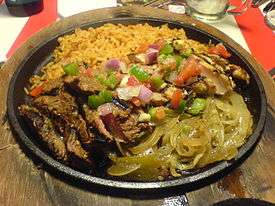Texan cuisine
| Part of a series on |
| American cuisine |
|---|
|
Regional cuisines
|
|
Ingredients and foods |
|
Ethnic and cultural |
|
Holidays and festivals |
|
| Wikibooks Cookbook has a recipe/module on |
Texan cuisine is the food associated with the U.S. state of Texas. Texas is a large state, and its cuisine is influenced from a wide range of cultural influences, including German, British, African American, Cajun/Creole, Mexican, Native American, Asian, and to a lesser degree, Jewish and Italian.
Tex-Mex
| Wikibooks Cookbook has a recipe/module on |
| Wikibooks Cookbook has a recipe/module on |
Tex-Mex refers to a style of cooking that combines traditional Mexican cuisine with American tastes and cooking techniques. Tex-Mex cooking differs from traditional Mexican cooking by using different proportions or types of ingredients, such as meats (like ground beef), melted cheeses, and spices more suited to the American palate. Tex-Mex cuisine has influenced what is often called "Mexican" cuisine in many parts of the U.S. and Europe. Dishes associated with Tex-Mex cooking include guacamole, chile con queso, tortilla soup, nachos, tacos, enchiladas, fajitas, quesadillas, chimichangas, burritos, tamales, and carne guisada. Texas caviar is a salad of black-eyed pea and corn lightly pickled in a vinaigrette-style dressing. Breakfast items include scrambled eggs tacos in flour tortillas, migas (especially in Austin), huevos rancheros, empanadas, along with sides of home fries, and refried beans. Deserts include flan (a custard), tres leches cake, fruit sherbets, and pralines.
Texas barbecue

Barbecue in Texas has distinct characteristics which make it different from barbecue in other parts of America. Unlike forms of barbecue which use pork as the primary meat, Texas barbecue depends heavily on beef. Smoked brisket (slowly cooked in a "pit") is one of the most used cuts of meat, along with smoked sausage and beef ribs. Techniques and flavors associated with Texas barbecue show influences of European immigrants, especially Czech and German, as well as Mexican, Caribbean/African American, and Native American cuisines.
Texas barbecue is often served with sliced white bread, mac & cheese, pickles, sliced onion, and jalapenos; sides include pinto beans, potato salad, cole slaw, and desserts of fruit cobbler and banana pudding.
Hamburger
The earliest claim to the invention of the hamburger was Fletcher Davis of Athens, Texas, who was claimed to have served it at his restaurant at a time when there were more cows than people in Texas. According to oral histories, in the 1880s, he opened a lunch counter in Athens and served a "burger" of fried ground beef patties with mustard and Bermuda onion between two slices of bread; with a pickle on the side.[1] The claim is that in 1904, Davis and his wife Ciddy ran a sandwich stand at the St. Louis World's Fair. Historian Frank X. Tolbert noted that Athens resident Clint Murchison said his grandfather dated the hamburger to the 1880s with "Old Dave" a.k.a. Fletcher Davis. A photo of "Old Dave's Hamburger Stand" from the 1904 connection was sent to Tolbert as evidence of the claim.[2] Also the New York Tribune namelessly attributed the innovation of the hamburger to the stand on the pike.
Fajitas

The first culinary evidence of fajitas, as a cut of meat, the cooking style (directly on a campfire or on a grill), and the Spanish nickname going back as far as the 1930s in the ranch lands of South and West Texas,. During cattle roundups, beef cattle were butchered regularly to feed the hands. Throwaway items such as the hide, the head, the entrails, and meat trimmings such as skirt were given to the Mexican cowboys called vaqueros as part of their pay. Hearty border dishes like barbacoa de cabeza (head barbecue), menudo (tripe stew), and fajitas or arracheras (grilled skirt steak) have their roots in this practice. Considering the limited number of skirts per carcass and that the meat wasn't available commercially, the fajita tradition remained regional and relatively obscure for many years, probably only familiar to vaqueros, butchers, and their families.[3] The modern "fajitas" were introduced at a county fair in Kyle, Texas in 1969 by Sonny Falcon, who later opened an Austin restaurant offering fajitas as a main fare. Fajitas are generally marinated before grilling in a combination of lime juice and southwestern spices, and then served on a hot plate splashed with lime juice and eaten in taco style with flour tortillas, grated cheese, pico de gallo, sour cream, and guacamole.
Other foods
Texas is known for its own variation of chili con carne. Texas chili is an ingredient in Frito pie, a dish made with the eponymous Fritos corn chip, invented in Texas and produced by Plano, Texas-based Frito-Lay corporation. Chicken fried steak is a traditional Texas dish, a variation on schnitzel that came to Texas along with German immigrants. Czech immigrants brought a tradition of kolache-making, a fruit-filled or sausage-filled pastry. Southeastern Texas shows strong Cajun and Creole influences in its foods. West Texas cooking is characterized by cowboy influences, such as chuckwagon cooking. Tex-Jex is Tex-Mex with a Jewish influence.[4]
References
- ↑ Nancy Ross Ryan (February 6, 1989). "Restaurants & Institutions. Reed Business Information, Inc. (US)".
- ↑ John E. Harmon. "Atlas of Popular Culture in the Northeastern United States".
- ↑ Wood, Virginia B. (March 4, 2005). "Fajita History - Food - The Austin Chronicle". The Austin Chronicle. Retrieved February 25, 2013.
- ↑ Schmidt, Alex (January 6, 2012). "Jewish And Mexican Cooking Meet In 'Challa-peño' : NPR". NPR.
External links
- Tex-Mex foods at Texas State Historical Association
- Texas barbecue at Food Network
- Cuisine of Texas at Allrecipes.com
